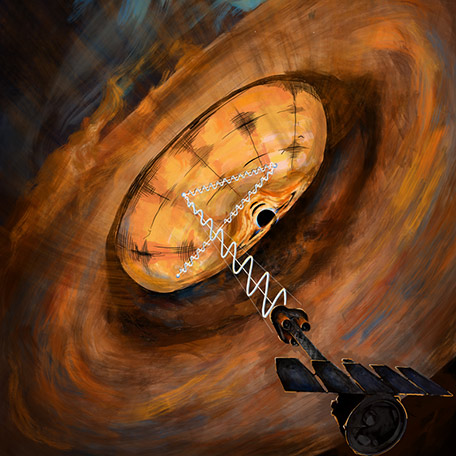Hidden treasure in the Galaxy
Hidden treasure in the Galaxy
Published on: 24 June 2024
Astronomers have uncovered that a well-known X-ray binary, whose exact nature has been a mystery to scientists until now, is actually a hidden ultraluminous X-ray source.
When it comes to the most powerful phenomena in the Universe, the release of gravitational energy in X-ray binary systems stands out as a highly efficient process. X-ray binaries are intriguing systems consisting of two celestial bodies: a normal star and a compact, dead object such as a black hole or a neutron star that sucks material from its stellar companion. A few hundred such sources have been identified thus far in our Galaxy.
Among the first X-ray binary systems discovered in the cosmos is the system Cygnus X-3. Since the early 1970s, this binary system was noted for its ability to briefly emerge as one of the most intense radio sources, yet in a few days’ time it dims or vanishes altogether. These peculiar characteristic spurred early efforts, coordinated by telephone calls, to unite astronomical observations across the globe. The unique behaviour of the system during these short-lived, highly energetic events, contrasting its otherwise “normal” nature, led to it being dubbed the “astronomical puzzle Cygnus X-3” by R.M. Hjellming in 1973. Numerous efforts have been aimed at understanding its nature ever since.
The breakthrough in unravelling this puzzle has been achieved thanks to the study of this system with the satellite Imaging X-ray Polarimetry Explorer (IXPE). According to Alexandra Veledina, an Academy Research Fellow at the University of Turku and the lead author of the study, the use of X-ray polarized vision has provided insights into the configuration of matter surrounding the compact object (probably a black hole). Veledina explains: “We have discovered that the compact object is surrounded by an envelope of dense, opaque matter. The light that we observe is a reflection off the inner funnel walls formed by the surrounding gas, resembling a cup with a mirror interior.”
This revelation has led to the identification of Cygnus X-3 as a member of the class of ultra-luminous X-ray sources (ULXs), which consume matter at such a gargantuan rate that a considerable fraction of the in-falling material is thrown violently away from the system. "ULXs are observed in distant galaxies.", explains Dr Adam Ingram, Senior Lecturer in Astrophysics and Royal Society University Research Fellow at Newcastle University, and co-author of the study, which was published in the journal Nature Astronomy.
"They appear faint in our telescopes, but once you account for how far they are from us, we find that they must be intrinsically extremely bright. In fact, their brightness appears to exceed the theoretical maximum that can be reached by the process of gas falling onto a compact object. However, we think that we are actually viewing ULXs down a huge funnel that amplifies their emission. If we viewed instead from the side of the funnel, we would instead see something like Cygnus X-3."
This significant finding marks a new chapter in the investigation of this extraordinary cosmic source, offering an opportunity for in-depth exploration of extreme matter consumption.
Image credit: A view towards the black hole in an X-ray binary and the X-rays we see that are reflected from the inner surface of the powerful outflow surrounding the hole.
Reference
Veledina, A., Muleri, F., Poutanen, J. et al. Cygnus X-3 revealed as a Galactic ultraluminous X-ray source by IXPE. Nat Astron (2024). https://doi.org/10.1038/s41550-024-02294-9
Adapted with thanks from the University of Turku.




